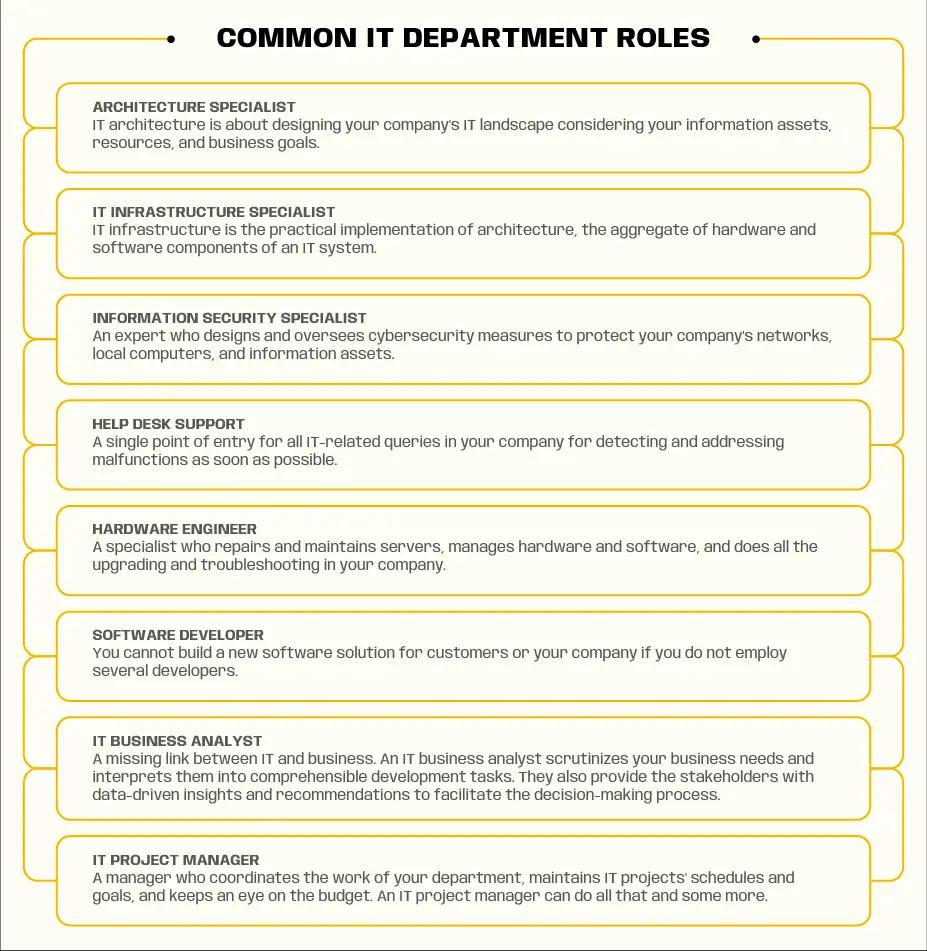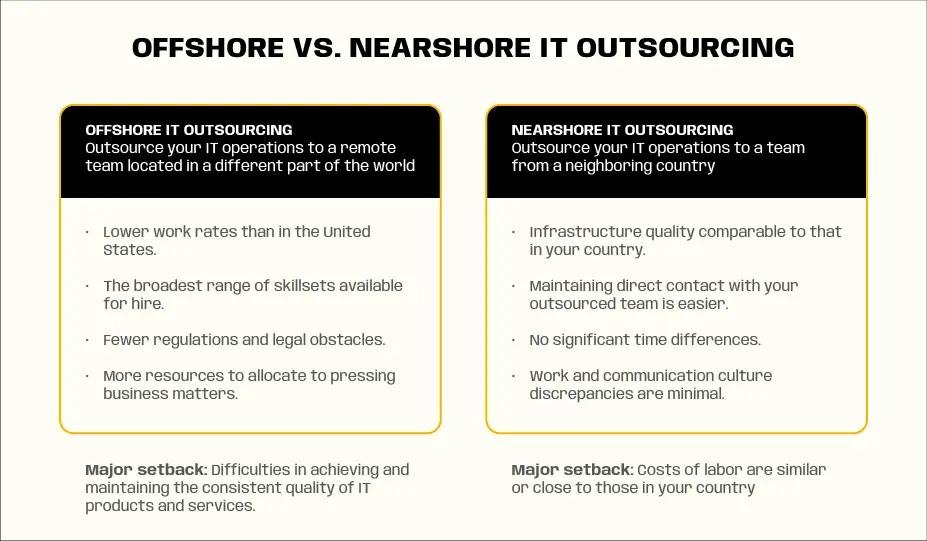Having an IT department is a must for any business today. A well-rounded IT team will help you achieve your business goals by managing the technological assets of your company. Specifically, you need it for:
- Maintaining your company’s computer infrastructure
- Ensuring compliance and processes documentation
- Enhancing communication between different departments
- Providing technical support and troubleshooting
- Planning technology investments
- Enforcing cybersecurity
- Developing new technologies, and more
But it is not just about making your computer network tick – it is also about saving your money and intellectual property. In 2019, IT-related issues cost businesses over $3.4 billion in lost productivity: inability to trade, to provide services, and so forth. Forty-six percent of companies were breached or attacked by hackers in 2020, which resulted in significant data losses. Failing to comply with GDPR policies can be costly, too – fines of over $3.4 billion in lost productivity: inability to trade, to provide services, and so forth. $28 million are more than real in 2021.
To secure yourself from these and other problems, you need an IT department. Let us outline a possible plan of action for building your new IT team from scratch.
How to build an IT department
Gathering tech-savvy people at one place and delegating them all the IT tasks and processes does not conclude the task. To succeed, you need to be strategic.
Decide on the organizational structure
The nearly Shakespearean question that you will likely stumble upon in the beginning is, “To centralize or not to centralize?”
A centralized structure is more traditional and implies that you have one IT department under the management of a CIO. Centralization results in:
- Better defense from cyber-attacks
- Lowered expenses
- Effective decisions made in line with your business goals
The main challenge is prioritizing: in which order should a single IT team address the requests from each line of business when each LOB believes their matter is the most pressing one? Sixty-three percent of companies agree this is indeed a problem.
The alternative to this approach is decentralization: creating multiple IT cells for the specific needs of each LOB. The benefits include:
- Shorter time-to-deploy
- Increased rates of innovation
- Higher staff satisfaction from work
Security and compliance are the two significant challenges here. Decentralization often leads to working with non-secure solutions, poor compliance, and no single standard for data protection.
The approach to how to build your IT department depends on your organization’s policies, leadership style, the size of your enterprise, budgets, and other factors.
Set the right goals
For an IT team to positively impact your revenue, we recommend you keep its purpose (development, support, operations and maintenance, and so forth) and goals in line with your business objectives.
These goals may be short-term or long-term, but all of them should be SMART: specific, measurable, achievable, relevant, and time-bound.
For instance, your IT specialists will have a hard time doing something like “improve communication efficiency between departments.” On the other hand, goals such as “Migrate to a cloud within the next four months” or “Design and deploy enhanced cybersecurity measures by 2022” match the SMART criteria and have more chances to be completed.
Decide on the roles
Depending on what you are building an IT department for, you may need specific skillsets. Some of the most common roles include:
Create a job description
If you want to recruit experts with the skills relevant to your goals, you need to create a specific and detailed job description. Some of the points to cover include:
- The role you are hiring for
- Duties your new IT specialist will perform
- Skills they must possess
- Work conditions that you provide
Interview and test the candidates
Prepare test assignments and question lists in advance to:
- Determine each candidate’s expertise in their field
- See how they handle complex tasks and address problems
- Evaluate their soft skills
Onboard your new employees and monitor their performance
This step is crucial for helping new team members disclose their full potential during the probation period. How crucial? Research shows that proper onboarding can raise your new employees’ productivity by 70 percent and increase the retention rates by 82 percent.
So, if a talented employee is not performing all that well during the probation, perhaps you should revise your onboarding procedures.
How to make an IT department more cost-effective
The major setback you will run into when building an IT department is costliness. Many businesses start with in-house IT teams because internalized processes result in higher security and performance. The downside is that a fully staffed in-house IT team can cost you a fortune.
The direct and hidden expenses with this business model are indeed significant. Let us take an IT infrastructure manager, for instance. According to Glassdoor, their expected annual salary is around $108,000.
Add FICA (Social Security and Medicare) and Unemployment Insurance taxes, the 401K retirement plan, insurance payments, and some other indirect expenses – and watch the costs of employing just one in-house IT specialist skyrocket.
Because of this, many companies are already abandoning the in-house business model: in 2020, 70 percent of companies outsourced their help desk support, software QA and testing, and other IT services for cost reduction.
Another problem is the skill shortage: companies have difficulties finding cybersecurity specialists (35 percent), technical architecture experts (22 percent), and data analysts (22 percent).
To avoid these challenges, enterprises choose offshore and nearshore outsourcing: in 2019 alone, the global IT outsourcing revenue reached $66.5 billion, and this number keeps growing.
You do not have to maneuver between the advantages and drawbacks of these models. We recommend that instead, you combine the benefits of in-house and outsourcing. To do this, you can keep the core IT operations in-house while delegating other tasks such as help desk support to your “extended offshore teams.”
Hybrid mode allows you to:
- Reduce your expenses by outsourcing to remote IT department team members
- Free your core IT team for more important tasks such as security
- Avoid intellectual property issues: all IP your team generates stays in-house
- Expand your talent pool
- Share valuable experiences and best practices across international teams
With the hybrid approach to IT operations, you can maintain high security and performance and reduce the costs of having a fully staffed IT department.
How to sustain IT department
According to CIOs surveyed by KPMG in 2020, strong team culture is the top factor for retaining IT talents. To build it, we recommend you to:
- Promote and maintain a work environment where everyone has a space to share their ideas, communicate issues, and request support. Become more available to your employees: a shorter chain of command will make your IT department more efficient by facilitating autonomous decision-making.
- Foster transparency. Communicating the logic behind your goals and decisions increases your team’s engagement in the ongoing business processes. This is important during the COVID-19 pandemic when many remote workers feel detached and indifferent.
- Reward initiative and good performance. Rewarding and appreciation help your IT specialists see their work’s meaning and value and increase their commitment.
Further CIO insights on how to sustain IT department mention providing your IT staff with:
- Decent wages and benefits
- Career opportunities
- Flexible work conditions
- Training and reskilling opportunities
The IT industry is a complex living organism that is constantly evolving. Consequently, you either adapt to changes or drag behind. To avoid the latter, we provide industry leaders like you with professional IT consulting services to help you build your in-house or remote IT department quickly and cost-effectively.
FAQ
How big should an IT department be?
There is no “one-fits-all” solution: you will have to search for the golden middle yourself.
The benefits of larger IT departments:
- More universal due to comprising multiple roles
- Suitable for a centralized structure
- Effective division of labor between numerous IT specialists
The benefits of smaller IT departments:
- The role of each team member in the overall result is well noticeable
- Suitable for a decentralized structure
- Taking ownership of tasks is more common
What makes an IT department successful?
Some of the attributes that many successful teams share are:
- Implementing proactive measures to prevent problems from happening rather than reacting to them
- Alignment to your company’s goals and a clear understanding of how IT impacts other business processes
- Extensive automation
- Keeping in touch with the technology trends
- Sharing technical knowledge among other employees instead of gatekeeping it
How do you measure your IT department’s performance?
You know that your IT staff is performing well if:
- The percentage of the resolved help desk tickets is high
- Your department’s expenses fit into your company’s IT budget
- The average response speed of your IT team to other LOB’s requests is satisfactory
- There are tested disaster recovery plans for the systems critical to your business
- Your team provides continuous uptimes for all the crucial systems
- The percentage of security breaches and active system vulnerabilities is low
- Your IT projects are completed on time





